Create a Chemical-free home
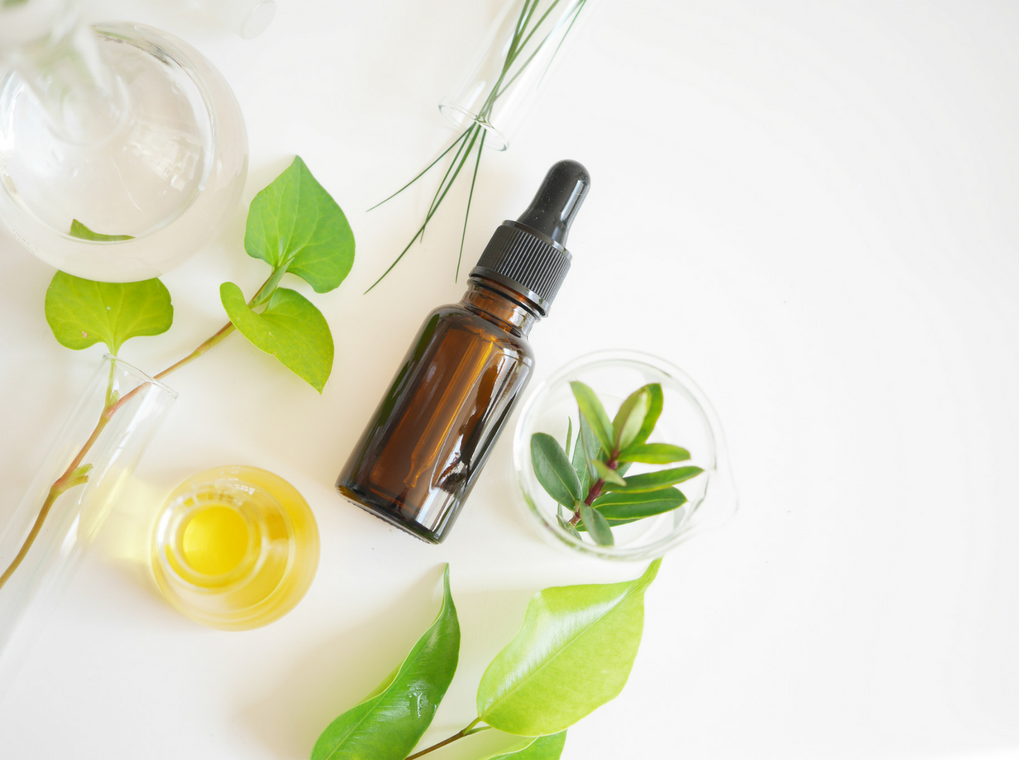

One of the biggest environmental and health threats we face today is not coming from the big companies dumping waste into the environment. It’s coming from the billions of consumers using chemical-laden products in their homes and on their bodies on a daily basis – chemicals like:
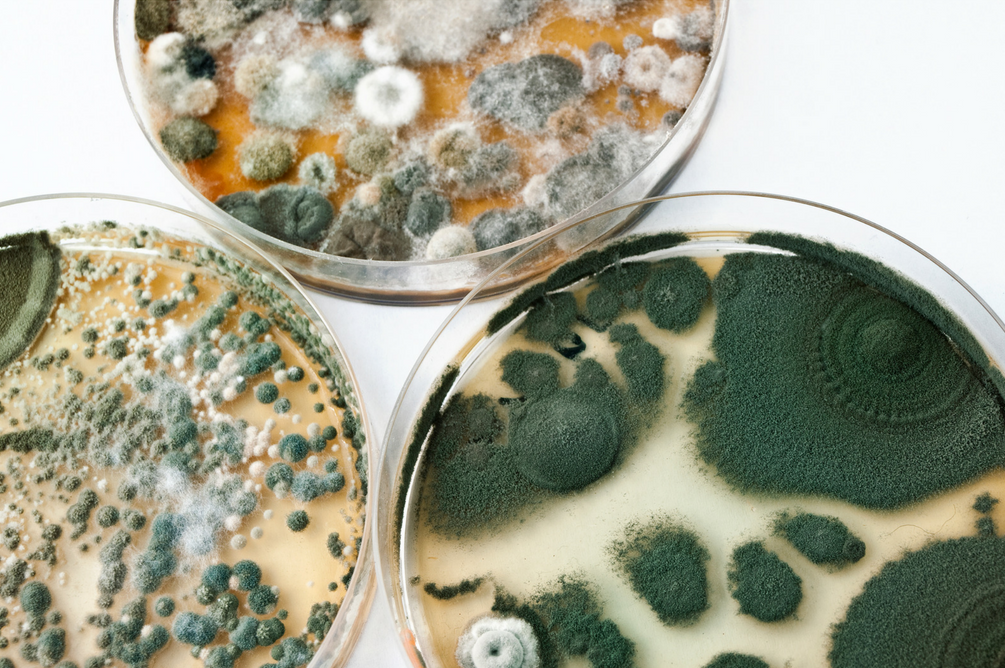
If you want to live a long, healthy life and ensure your children and pets remain active and resilient, going chemical-free in the home is a “must”. You only have to do a google search to find out more of the horrific ramifications to our own health and the health of the Planet from all the chemicals that are present in your regular brands of cleaning and personal care products.
Switching to a chemical free home takes action, however Young Living has made it an extremely easy and cost-effective option using their Thieves range of products.
Make the decision today to stop using synthetic fragrances and commercial personal care and cleaning products, and to switch to healthy alternatives like essential oils. Just as essential oils help to keep the plant healthy, they also keep us healthy.
Let’s start by talking about what Thieves oil is, given that it’s the foundation of this range of products.

6 versatile uses for the Thieves essential oil blend
Thieves is an essential oil blend inspired by a story of four Thieves in Medieval Europe who anointed their body with a vinegar containing various herbs and spices. If you want to learn more about this part of medieval history, google the “Four Thieves Vinegar”.
The Thieves oil blend by Young Living is not an exact replica of the original. It uses Clove and Rosemary which were two of the herbs in the Four Thieves Vinegar, but it also incorporates other powerful essential oils like Cinnamon Bark, Lemon and Eucalyptus. Think of it as your personal bodyguard:
1. Apply several drops a day under each during the winter months to keep yourself healthy
2. Put a splash of Thieves Household Cleaner and 6 to 8 drops of Thieves oil on a sponge and use to wipe over surfaces (such as walls) that have mold or mildew on them
3. Add 40 drops into 4 litres of Acrylic or Enamel paint to keep the mold at bay (eg. in wet areas like bathrooms)
4. Use a full bottle of Thieves oil in an Aromalux diffuser and diffuse for several hours a day in a moldy room until the bottle is finished. Young Living’s Aromalux diffuser doesn’t use water, so it’s the ideal diffuser to use wherever moisture is an issue (as in the case of mold)
5. Add a few drops of Thieves oil to a sponge and wipe down kitchen benches
6. Add 10 to 20 drops of Thieves oil or Purification oil to your Young Living diffuser to kill airborne bacteria, viruses and mold, and to freshen the home
Scientific studies have shown that after just 10 minutes of diffusion of Thieves Essential oil blend, there was:
This increased to a 99.96% reduction in the number of Pseudomonas aeruginosa bacteria after just 12 minutes of diffusing, and a 99.3% reduction in the number of gram positive Micrococcus luteus organisms after 20 minutes of diffusing. -1997 Weber State University study on diffused Thieves oil.
This is an oil blend you can rely on to keep your home clean and protected. And it is so popular and effective that Young Living developed an entire range of products based on this Thieves blend, including cleaning and dental care products.
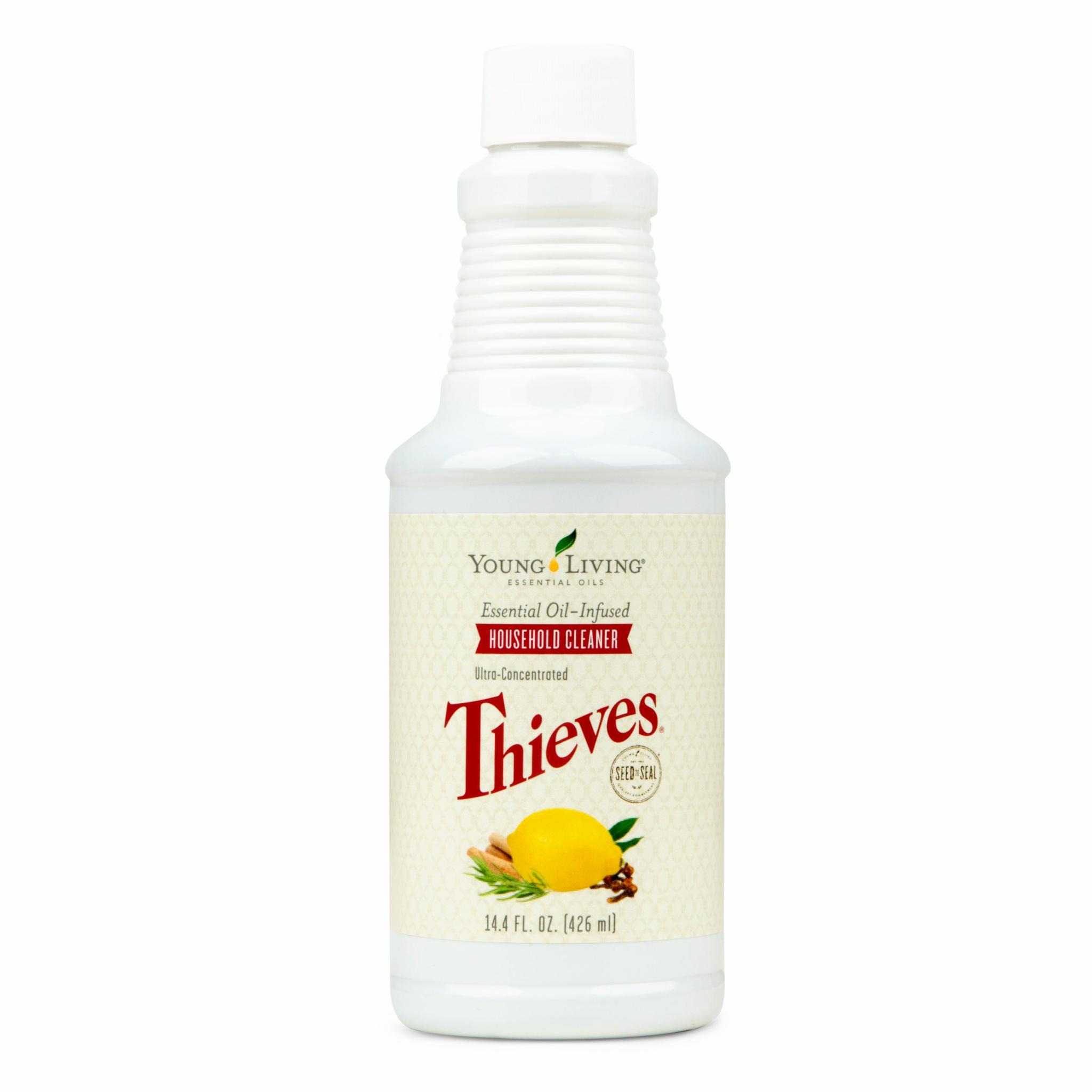
Clean your entire Home with Thieves Household Cleaner
There is one product that should be at the very top of your Chem-Free Home shopping list, and that’s Thieves Household Cleaner (THC).
This all-purpose concentrated cleaner is made from 100% plant and mineral based ingredients and is completely biodegradable. It comes in 2 handy sizes:
It is so cost effective that it often matches or is even cheaper than your supermarket cleaning brands, especially when you are using the 1.8 litre size. Yet it’s also incredibly versatile – this one cleaning solution will save you from having multiple different bottles of cleaner in your home. Here are just some of our favourite recipes:
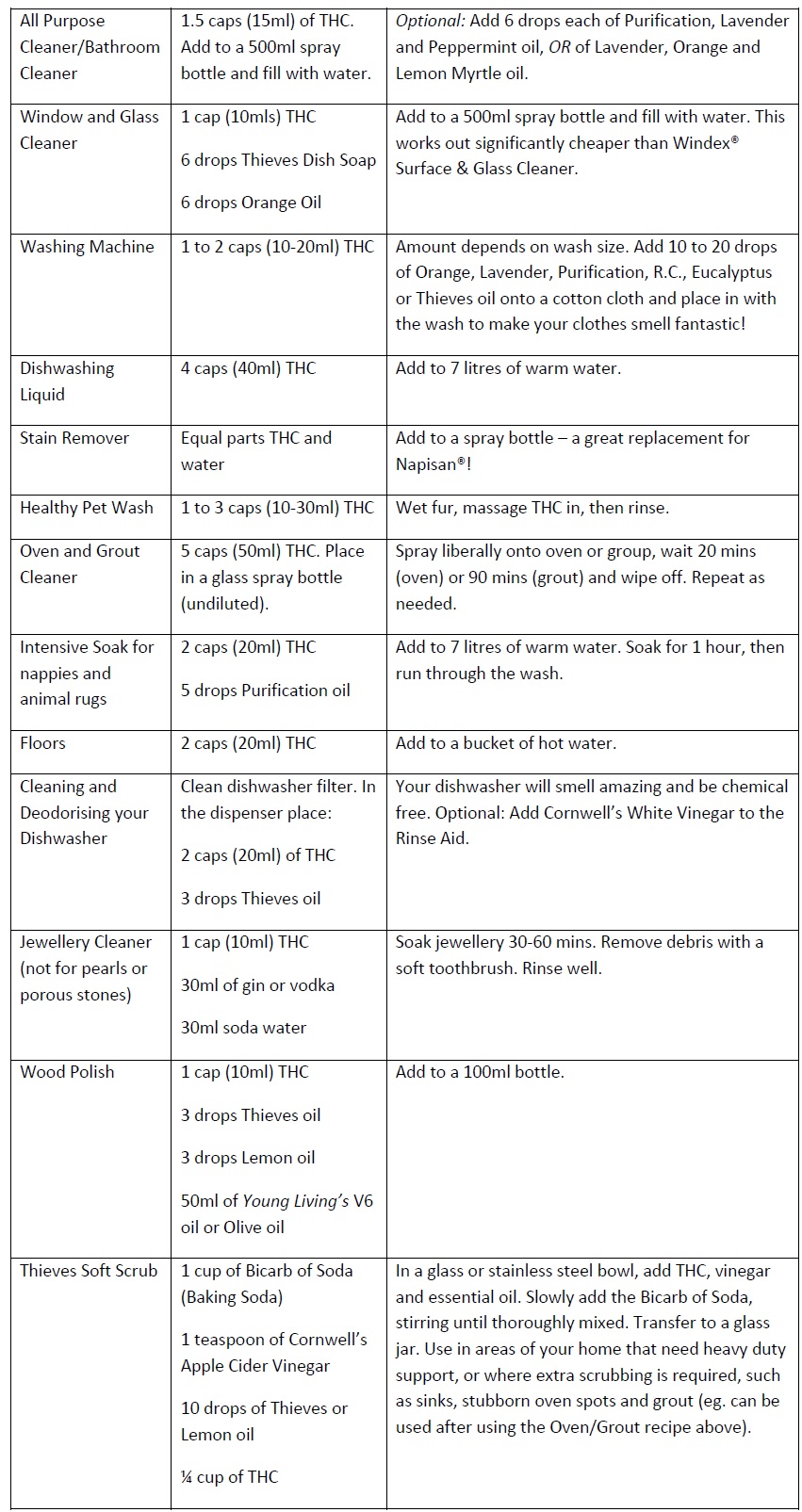
Other Essentials from the Thieves Product Range
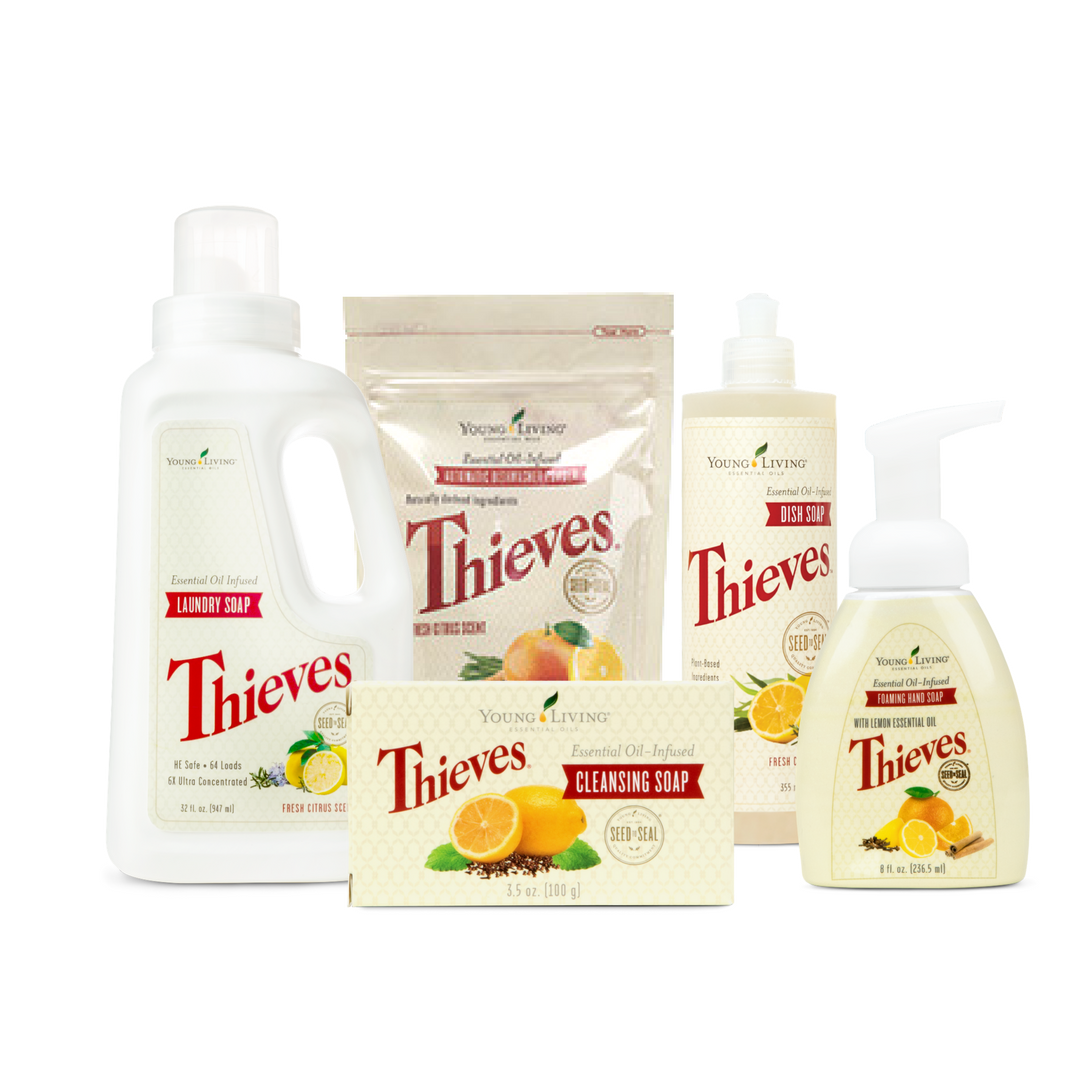
Although the Thieves Household Cleaner can be used in the washing machine and to wash dishes, Young Living has added to their Thieves Range with the Thieves Dish Soap, Thieves Laundry Soap and Thieves Dishwashing Powder for these specific household applications.
They also have the Thieves Foaming Hand soap (also available in Lavender), which is an exceptional hand soap and perfect for the sink, vanity and laundry tub. This creamy foaming soap is an absolute delight to use, and gentle on the hands. A squirt on a sponge makes it an alternative to THC for wiping over surfaces such as benches and toilets. And if you prefer a bar soap for use at sinks and on your body, you will love the Thieves Bar soap – perfect for both men and women, and with the warm and spicy aroma of Thieves oil.
Protect your Teeth with the Thieves Dental Range
Have you heard that the dirtiest place in our body is in our mouth? In fact, according to Dr. John Richter, more bacteria live on the back of the tongue than on any other part of the body. Having healthy gums and teeth is therefore essential to good health, and this has been scientifically proven.
We say good health starts in the gut, but it can equally be said that it starts in the mouth!
So you want a toothpaste that is:
Many commercial toothpastes contain large abrasive particles that erode the tooth enamel. Loss of enamel is permanent, and once it’s gone, the softer dentin layer is exposed, greatly enhancing the risk of dental decay.
You want your toothpaste to have extremely fine particles – large enough to remove the plaque biofilm, but not so large as to create damage to the enamel.
This is what you get with Young Living’s Aromabright and Dentarome Ultra toothpastes, which are both fortified with the Thieves oil blend. What’s more, the Young Living toothpastes contain NO fluoride, sodium lauryl sulfate, parabens, propylene glycol, sugar, colours or synthetic chemicals. In fact, they are completely free of all known harmful ingredients. Compare this with buying a tube of Colgate® or other commercial toothpaste in the US, where it will usually contain a warning on it like:
“Keep out of reach of children. If more than a pea sized amount is accidentally swallowed, get medical attention or contact a poison control centre right away.”

Which is the best toothpaste to use?
Aromabright is the newer formulation, so that’s the best one to go with. It’s a little sweeter than Dentarome Ultra (due to the extra stevia leaf extract), and it also has a milder taste because it doesn’t contain Wintergreen oil.
Where Dentarome Ultra contains:
Aromabright Toothpaste additionally contains:
Young Living also has a toothpaste specifically designed for children, called KidScents Slique Toothpaste. This is an all-natural toothpaste that uses both the Thieves and the Slique Essence essential oil blends to gently clean and protect teeth. The Slique Essence blend contains a range of citrus oils, so it adds a flavor that children will love. The KidScents Slique toothpaste is safe, effective, and promotes healthy teeth without the use of fluoride, dyes, synthetic colors, artificial flavours or preservatives.
Learn more about how to incorporate essential oils into other dental regimes, such as oil pulling and using a WaterPik.
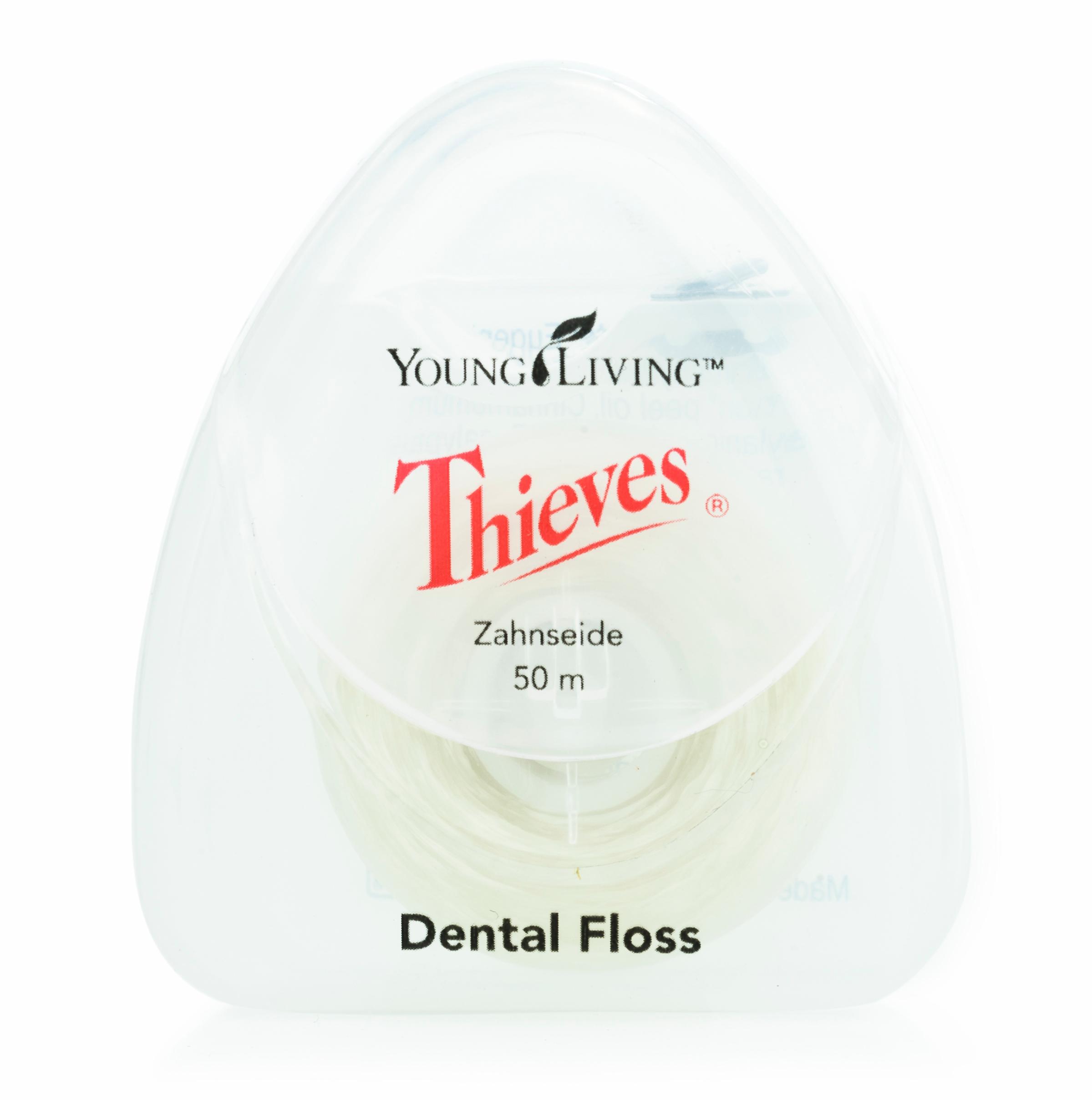
Thieves Dental Floss
Dentists recommend flossing at least several times a week, and preferably every day….but make sure you are using a healthy string floss. You definitely don’t want to be using commercial floss!!!! Most commercial dental floss contains petroleum-based dyes, artificial sweeteners, and is coated with Teflon, so it slides between your teeth easier.
Young Living’s dental floss is all natural, and uses bees wax and soy wax, and it is soaked in Thieves oil.
It’s the healthiest way to string floss, and a “must” for the handbag or briefcase for those times you find yourself with a stubborn piece of food caught between your teeth!
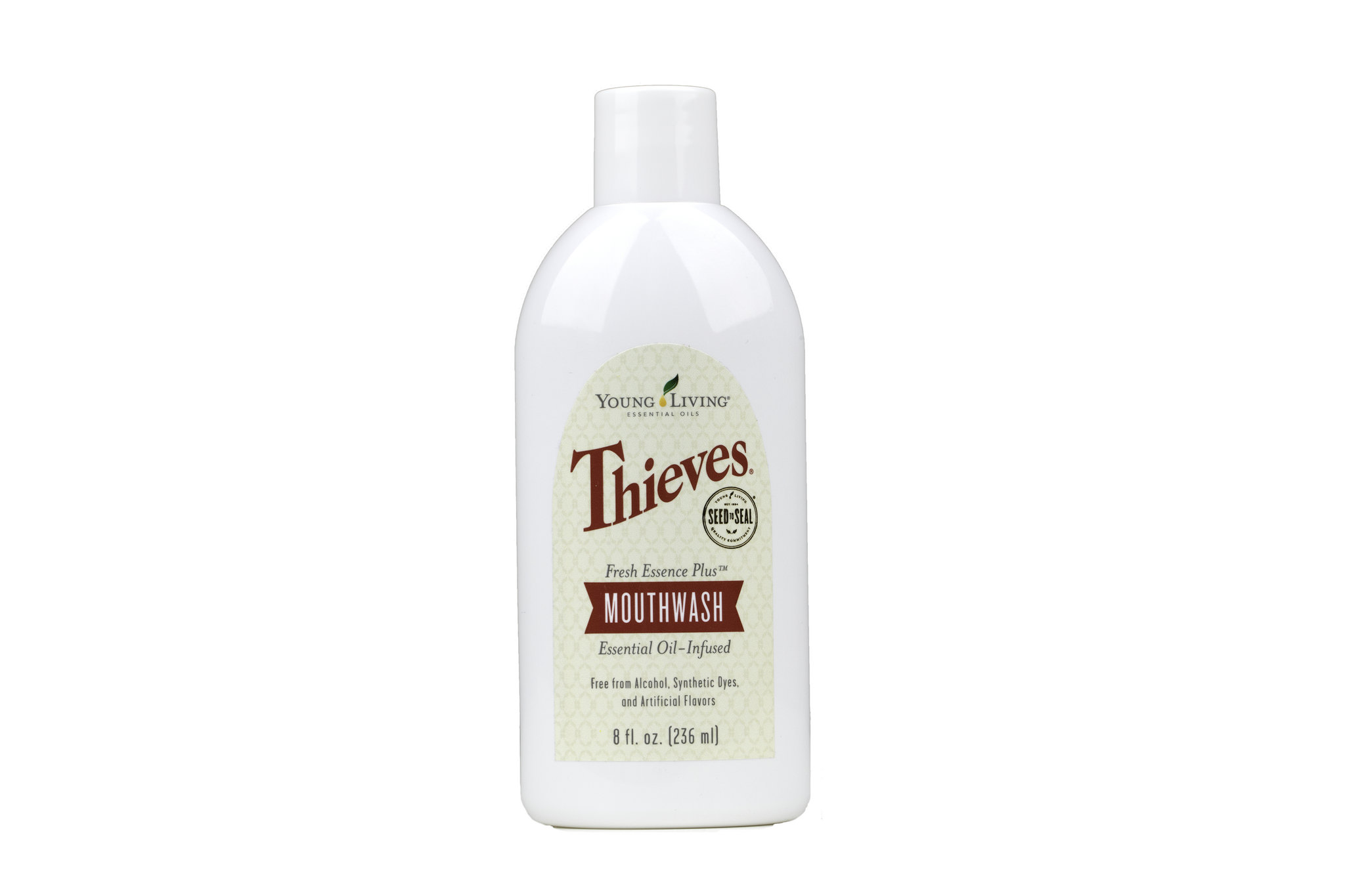
Thieves Fresh Essence Mouthwash
Put a blast in your mouth with the Thieves Fresh Essence Mouthwash. Put one capful in the mouth, and “swish” for 30 to 60 seconds.
Not only does it contain Thieves essential oil, it also has a burst of Peppermint, Spearmint and Vetiver essential oils for an extra clean mouth and fresh breath. It also has Peppermint Leaf water and Melissa Leaf Water, in addition to colloidal silver, vitamin E and stevia leaf extract. It contains only natural ingredients, and uses a patented, time-release technology which will keep your breath fresh for longer.
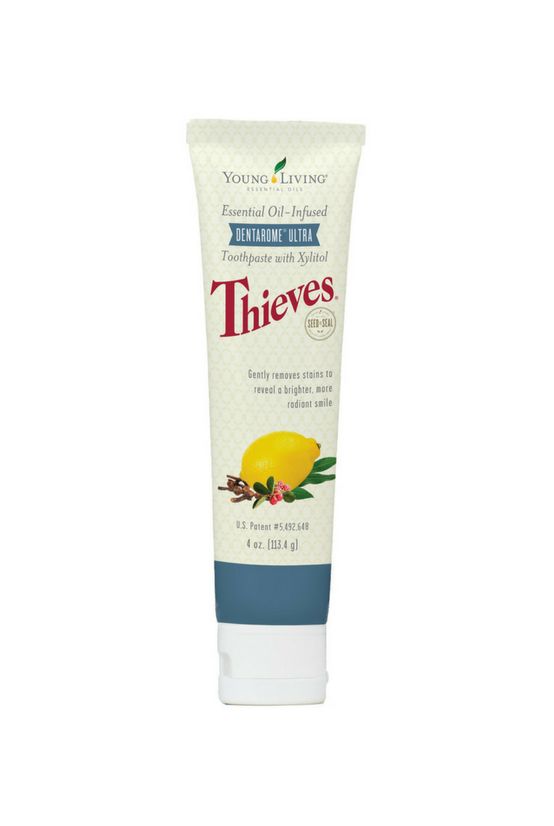
Try this underarm deodorant – the best you will ever try!
Young Living has another very popular toothpaste, called Thieves Dentarome Plus®. This is Young Living’s original toothpaste….but it’s no longer used as a toothpaste, because it’s not as advanced as AromaBright or Dentarome Ultra.
However – it’s perfect as an underarm deodorant…go figure! In fact, I guarantee it will be the best underarm deodorant you will have ever tried, and you’ll never want to go back to normal deodorant after you’ve tried it!
You need so little – half the size of a pea will do one (or even two) underarms. It spreads easily, and keeps you smelling fresh all day…in fact, most people find it lasts them 24 hours before they need to reapply. Because it contains Peppermint oil as one of its ingredients, it cools the skin….and because it’s cooling, you perspire less.
A word of caution: If you use too much, it will feel like the Peppermint is biting you. This sensation will last for 10 minutes or so, and if it’s too intense, put some vegetable oil like V6 or olive oil over the top. This just reminds you to use less next time!
And if you just can’t get your head around using a toothpaste as an underarm deodorant, Young Living has two non-toxic underarm deodorants as part of their personal care range, called AromaGuard (in either Meadow Mist or Mountain Mint aroma).
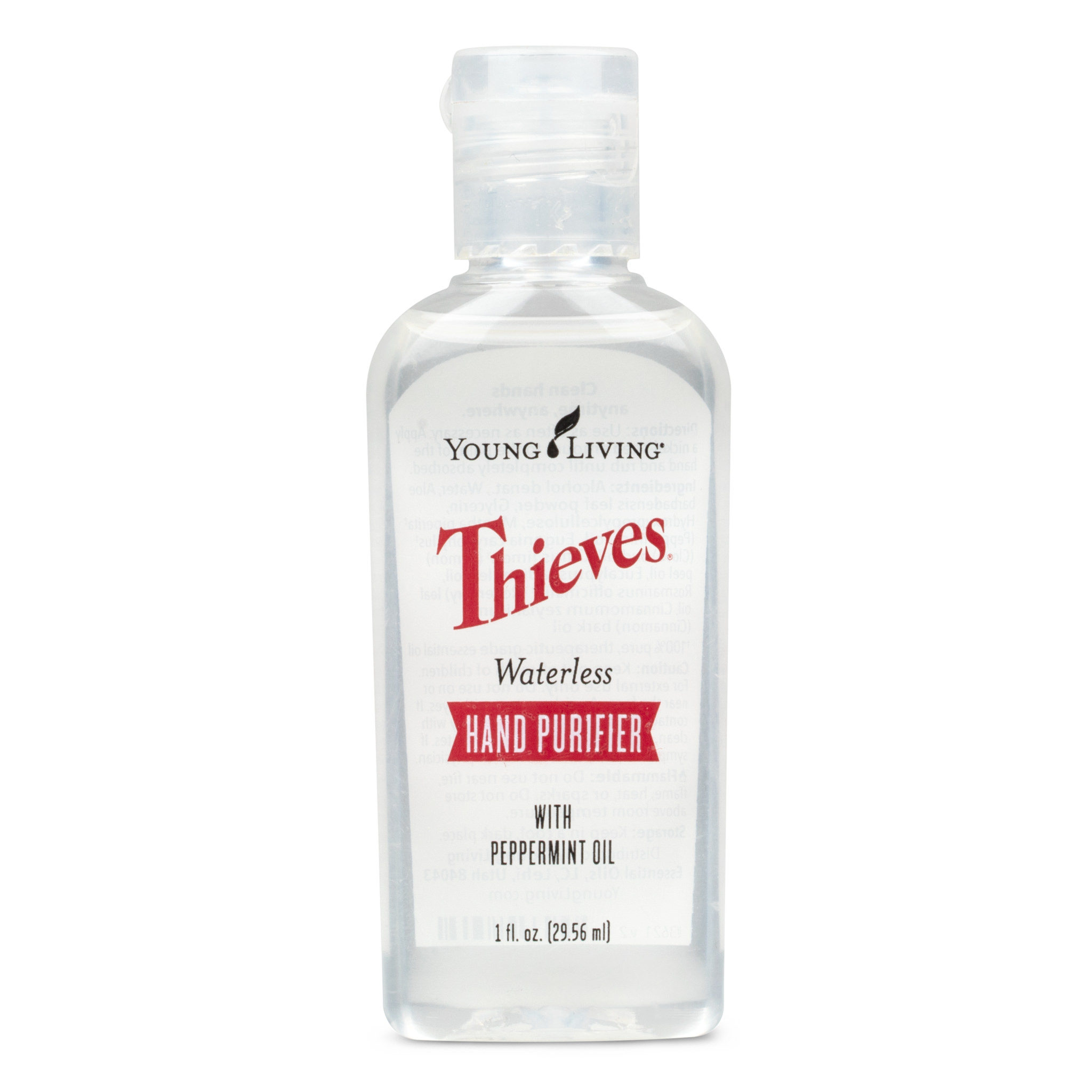
Thieves® Spray & Waterless Hand Purifier
If you are serious about going Chemical Free, you’ll want to avoid the heavily fragranced and chemical-laden soaps available in public washrooms. Instead, use one of these handy Thieves products for purifying your hands “on the go”. They are the perfect size to be carried in your handbag, pocket or briefcase….and the Thieves Spray can even be used to remove whiteboard marker off whiteboards, and to give your roses a freshen-up!
AromaGize your home with essential oils
Companies know that smells evoke positive emotions within us, so aromas and perfumes have become an important part of our modern world. Most household products and cosmetics are scented, from dishwashing liquid to toilet and room deodorisers, to facial products.
However, synthetic scents are much cheaper to produce than using nature’s aromas. So instead of turning to nature, big companies turn to chemicals to recreate nature’s smells. A single fragrance can contain hundreds if not thousands of toxic chemicals.
One of the most common groups of chemicals found in synthetic aromas are phthalates (pronounced “thal-ates”). This is part of the reason why in 2010, average age for a girl reaching puberty is 10.5 years of age, where in 1860 it was 16.6 years of age1,2,3. It’s also why men exposed to phthalates are secreting less testosterone4. This is serious, because testosterone is so important for male fertility!
Phthalate exposure in the womb and early childhood has now been linked with lower IQ levels, and is one of many potential triggers for ADHD5,6.
Phthalates in personal care products and cleaning products wash down the sinks and toilets, and from there make their way into our rivers and oceans. It’s no wonder researchers7 are now finding:

And of course it’s not just affecting our environment – it’s affecting our own bodies as well
So why take the risk and expose yourself and your human and animal family to synthetic fragrances?
Even if you are strong and healthy now, over time these chemicals still build up in your system to a point where they overload the liver, disrupt the hormones, undermine health and contribute to obesity.
1. Could exposure to phthalates speed up or delay pubertal onset and development? A 1.5-year follow-up of a school-based population, by Y. Zhang, Y. Cao, H. Shi, X. Jiang, Y. Zhao, X. Fang and C. Xie, Environment International. 2015 Oct; 83:41-9. Doi:10. 1016/j. envint.2016.06.005. Epub 2015 Jun 12.
2. Effects of Environmental Endocrine Disruptors on Pubertal Development, by Samim Ozen and Şükran Darcan, Journal of Clinical Research into Pediatry and Endocrinology. 2011 Mar; 3(1): 1–6. Published online 2011 Feb 23. doi: 4274/jcrpe.v3i1.01
3. http://www.nytimes.com/2012/04/01/magazine/puberty-before-age-10-a-new-normal.html?_r=3
4. Phthalates might interfere with testicular function by reducing testosterone and insulin-like factor 3 levels, by W.H. Chang, S.S. Li, M.H. Wu, H.A. Pan and C.C. Lee, Human Reproduction. 2015 Sep 18, pii: dev225 [Epub ahead of print]
5. Phthalate exposure and children’s neurodevelopment: A systematic review by M. Ejaredar, E.C. Nyanza, K. Ten Eycke and D. Dewey. Environmental Research. 2015 Jun 19;142:51-60. doi: 10.1016/j.envres.2015.06.014. [Epub ahead of print]
6. Association between phthalates and externalizing behaviors and corticol thickness in children with attention deficit hyperactivity disorder, by Park, J.M. Lee, J.W. Kim, J.H. Cheong, H.J. Yun, Y.C. Hong, Y. Kim, D.H. Han, H.J. Yoo, M.S. Shin, S.C. Cho, B.N. Kim. Psychological Medicine. 2015 Jun; 45(8):1601-12. doi:10.1017/S0033291714002694. Epub 2014 Nov 12.
7. From documentary “Poisoned Waters” (by Pulitzer Prize-winning journalist, Hedrick Smith)

AromaGize your home with essential oils
Make the choice to avoid commercial air fresheners, scented perfume sticks, and other scented household products. Instead, fill your home with nature, rather than fake smells. This benefits everyone – human or animal – who steps into your home.
Opt for a good quality diffuser like the ones available through Young Living, not an old-fashioned oil burner. The electric and candle oil burners use heat to disperse the aroma of the oil, and in so doing they destroy the beneficial constituents present in the essential oils.
Essential oil diffusers mist the oil into the atmosphere without using heat. The most popular ones are based on ultrasonic technology. They have a plate inside that vibrates at ultrasonic speeds of around 1.7 million waves per second, changing the water tension so that liquid becomes vapour.
Here are some great oils to diffuse, to turn your home into a living sanctuary that benefits everyone who enters.
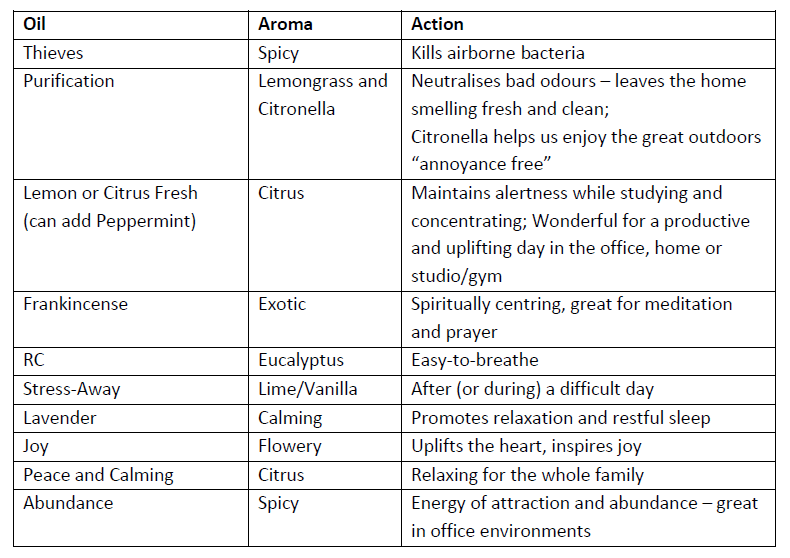
The great news is that these oils not only smell great, they also help to purify the home. There is an abundance of scientific studies on the air-purifying properties of essential oils, including these:
There are so many other wonderful chemical-free home tips, available in the book “Creating your Healthy Home” by Amanda Bell and Katie Bashford. For example:
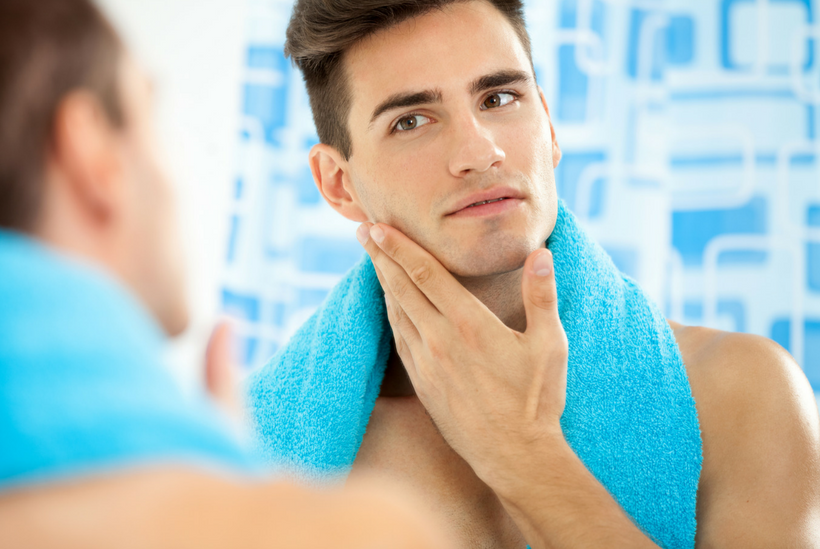
The Chemical Free Body
It’s not only your home that you want to keep chemical free – it’s also your body! Young Living has an extensive range of personal care products which are free of all known harmful ingredients, and which have the fragrance and rejuvenation benefits of therapeutic-grade essential oils. These include a wonderful range of:
Click here to explore Young Living’s entire range.